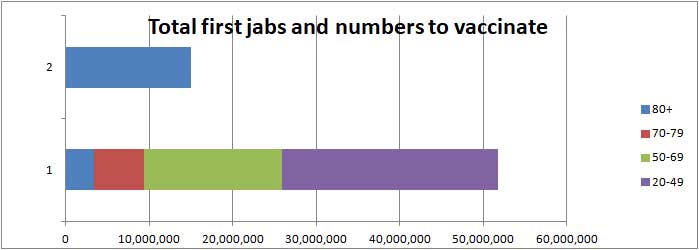
Angus and Rosemary's Miscellany
of Malvern - Other Resources
|
Coronavirus (COVID-19) epidemic weekly update for Malvern SeniorsCOVID LOCKDOWN in ENGLAND Alert Level raised to 5 on January 4th INFECTION RATE STILL HIGH PM says 'STAY AT HOME' Skip to menu of archived pages PreambleWe keep an eye on the published government figures to asses the level of risk in the Malvern Hills district, if there is an uptick in cases we will tell you. This page is updated every Sunday between 1800 and 2400 hours GMT. Information about Coronavirus can be found on the NHS website: https://www.nhs.uk/coronavirus
|
| Age band | First jabs % |
| 80+ | 91 |
| 75-79 | 95 |
| 70-74 | 74 |
| Under 70 | 10 |
First vaccinations reported by NHS to 7th February 2021 in England
Number of cases
This week the average rate of people testing COVID positive in the UK reported by PHE on the 'Coronavirus Dashboard' fell from 18,358 new cases per day to 13,200. The chart below shows how the daily rate has varied since 1st September.
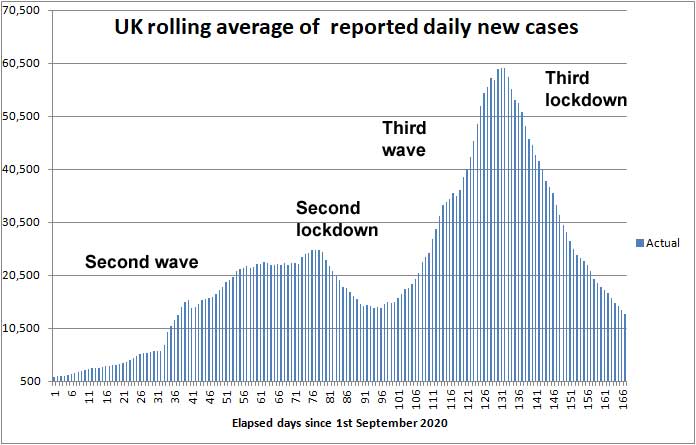
UK daily confirmed COVID cases 1st September to 14th February 2021
Cases have fallen exponentially halving every 18 days or so during the third lockdown.
During the last week the cumulative total of confirmed UK COVID cases reported by PHE rose by 92,398 to 4,038,078.
In Worcestershire there have now been 29,836 confirmed cases of COVID-19, an increase of 899 on the week. The daily number of new cases fell from 186 to 128 indicating R is still <1 and residents are doing a good job observing the lockdown.
The breakdown by Worcestershire Lower Tier Local Authorities (LTLA) is shown in the following table, together with comparisons for Herefordshire, a more sparsely populated county, and the city of Leicester.
Note: these figures are based on the 'Cases by area' (whole pandemic) data set of the Coronavirus Dashboard.
| Districts of Worcs | Cases | Weekly increase | Population |
| Bromsgrove | 5,798 | +133 | 98,529 |
| Malvern Hills | 2,433 | +84 | 77,545 |
| Redditch | 5,354 | +156 | 85,317 |
| Worcester | 5,559 | +162 | 103,542 |
| Wychavon | 5,805 | +210 | 126,240 |
| Wyre Forest | 4,887 | +154 | 100,957 |
| TOTAL | 298,836 | +899 | 592,130 |
| COMPARE WITH | |||
| County of Hereford | 6,311 | +148 | 195,000 |
| Leicester (city of) | 32,296 | +908 | 400,000 |
Cumulative cases reported by PHE in Worcestershire to 14th February 2021
Interactive map
At the bottom of the Coronavirus Dashboard (daily update) page there is an Interactive Map which is coloured to show the variation in infection rate across the country. This shows how the rate of infection has been steadily falling across the UK since the start of the lockdown.
Click for Interactive Map of COVID cases
Note: the Interactive Map works on desktop PCs but it's possible you may encounter difficulties using a tablet or smartphone.
Recent weekly cases to 9th February are: North Malvern 13; Malvern Link 13; Pickersleigh 10; Barnards Green 7; Malvern Wells and Priory 4; Callow End and Hanley 6; Upton and Welland 10. The picture changes daily.
Number of deaths
Statistics on COVID deaths are published by Public Health England, The Office of National Statistics, and NHS England; these show the third wave daily death rate has passed its peak and begun to fall.
PHE figures
Public Health England reports that the cumulative total of COVID (28) deaths in UK hospitals and care homes has risen by 4,701 in the last week to 117,166 while the daily average has fallen from 901 to 672; see chart below which shows the actual daily death rate in red, and our forecast to the end of February in blue.
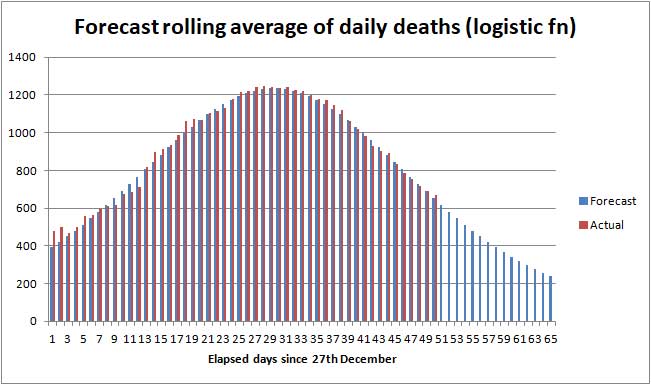
Actual daily UK death rate from 27th Dec to 14th February 2021 and forecast
Click to view the UK government Coronavirus Dashboard
In comparison averaged over recent years 1,700 people die daily from all causes.
In those districts where the COVID death rate is highest the storing of bodies in temporary mortuaries and delay to funeral services can be expected between now and the end of February.
ONS figures
The Office of National Statistics (ONS) separately reports registered deaths in England and Wales where COVID-19 is mentioned on the death certificate. The ONS figures lag the PHE figures by 10 - 14 days and do not include NI and Scotland, so are lower than the figures published by PHE.
The ONS figures are broken down by District providing a glimpse where deaths are occurring. The cumulative total of COVID related deaths in Worcestershire reported by the ONS up to 29th January 2021 (week 4 of 2021) is shown below.
| Districts of Worcs | Deaths 2020 |
Deaths 2021 |
Weekly increase | Population |
| Bromsgrove | 164 | 56 | +16 | 98,529 |
| Malvern Hills | 61 | 46 | +8 | 77,545 |
| Redditch | 108 | 40 | +11 | 85,317 |
| Worcester | 87 | 74 | +15 | 103,542 |
| Wychavon | 157 | 62 | +17 | 126,240 |
| Wyre Forest | 171 | 46 | +11 | 100,957 |
| TOTAL | 748 | 324 | +78 | 592,130 |
Cumulative COVID deaths registered by ONS to 29th January 2021
In the week ending 29th January, there were 78 COVID related deaths in Worcestershire, of which 27 were in care homes, 7 at home, 1 in a hospice and 43 in hospital; a fall on last week.
In total in England and Wales 8,785 COVID related deaths were reported by the ONS in the week to 29th January, a slight fall of 65 (0.7%) on the week before. A larger fall can be expected next week.
The highest number of hospital deaths (>29) by Lower Tier Local Authority were:
Leicester 39, Luton 31, Southend on Sea 34, Medway (Kent) 43, Cheshire East 32, Cheshire West 43, Cornwall 30, Wiltshire 50, Central Bedfordshire 34, Bournemouth Christchurch and Poole 67, Dorset 40, Buckinghamshire 68, Basildon 32, Basildon 32, Braintree 51, Chelmsford 42, Colchester 31, Tendring 56, Manchester 37, Liverpool 58, Sefton 39, Wirral 41, Sheffield 46, Birmingham 139, Coventry 31, Sandwell 63, Walsall 35, Wolverhampton 43, Barnet 50, Bexley 49, Brent 44, Bromley 52, Croydon 64, Ealing 46, Enfield 45, Greenwich 35, Hackney 31, Havering 38, Hillingdon 34, Islington 46, Lewisham 32, Newham 41, Redbridge 39, Sutton 33, Wandsworth 30, Betsi Cadwaladr University Health Board 42, Aneurin Bevan University Health Board 49, Cardiff and Vale University Health Board 39, Cwm Taf Morgannwg University Health Board 51.
Once again Birmingham had the highest death rate.
The cumulative total of COVID related deaths in England and Wales recorded by the ONS for all weeks of the epidemic rose to 117,527.
| Year | Cumulative COVID related deaths in England and Wales |
| 2020 | 85,686 |
| 2021 | 31,841 |
| TOTAL | 117,527 |
COVID death toll in England and Wales to 29th January 2021 (by ONS)
Click for national ONS data on deaths (Excel spreadsheet)
NHS England figures
More recently in the seven days ending 14th February NHS England reported the cumulative total of deaths in Worcestershire hospitals rose by 33 to 781.
Click for NHS COVID-19 Daily Deaths
Healthcare numbers
The UK government Coronavirus Dashboard includes important information about healthcare statistics.
| Hospital cases (UK) | Number | Weekly change |
| Patients currently in hospital | 23,341 | -5,985 |
| Patients on ventilation | 2,943 | -562 |
| Patients admitted daily | 1,715 | -617 |
Headline summary of patients in hospital as reported 14th February 2021
These headline figures show the number of COVID patients in hospital has continued to fall steeply.
The number of patients on ventilators has fallen 25% from the peak but is about the same as at the peak of the first wave which is bad news as the outcome for patients on ventilators is poor.
Daily admissions are down again which is encouraging. The steady state number of COVID patients in hospital seems to be roughly ten time the number of patients admitted daily, suggesting a fall to 17,000 patients is on the way.
Figures for bed occupancy in Worcestershire hospitals can be found on the NHS England website:
Click for NHS England COVID-19 Hospital Activity
On 9th February there were 196 COVID patients occupying beds in Worcestershire Acute Hospitals at Worcester, Kidderminster and Redditch (a fall of 12% on last week), and a further 52 in 'care' hospitals, a fall of 19% on last week. In England a total of 22,067 COVID beds were occupied a fall of 20% on last week.
Note: The Welsh First Minister said some time ago that very sick COVID patients arrive in hospital 7 to 10 days after first symptoms, and either die or are discharged 15 to 30 days after first symptoms in most cases. Hospital beds are occupied by suspected COVID patients, very sick COVID patients, and a few suffering from 'Long COVID' who may remain in hospital for much longer than 30 days.
Notes on projected figures for deaths
It appears hospitals are only admitting very sick COVID-19 patients, for example those with breathing difficulties, which is probably why Professor Peter Horby of Oxford University said last year on the Andrew Marr show that up to 20% of COVID patients in hospital could die. One might have expected the percentage to reduce as treatments have improved but this does not appear to have happened and we have a suspicion the situation might actually have worsened during late December and early January. We have found this projection no longer gives reliable advance warning of deaths.
Statistician Sir David Spiegelhalter of Cambridge University speaking separately on BBC TV said that, using his rule of thumb, hospital admissions were likely to be about 10% of reported new cases, one week after symptoms; and deaths were likely to be about 2% of new cases, 2 to 3 weeks after that - which would point to about 264 hospital deaths per day by the end of February.
Looking further ahead, once a significant percentage of the population has been vaccinated neither rule of thumb will apply, and COVID deaths should fall sharply.
Forecast for the week ahead
Trends suggest that during the next seven days (up to 21st February) the cumulative total of new UK COVID-19 cases reported by PHE on the Coronavirus Dashboard could increase by about 80,500 towards 4,118,500.
In Worcestershire up to 700 new cases of COVID-19 can be expected, and possibly up to 70 cases in the Malvern Hills district.
We estimate the number of COVID (28) deaths could increase by about 3,500 nationally towards 120,750 during the 7 days ending 21st February 2021.
In the county of Worcestershire, assuming a 2.4% death rate, the 899 new cases this week could translate to about 21 Worcestershire deaths per week by the end of February, but if cases are mostly confined to younger age groups it could be less.
Longer term forecast
Ending of the third wave of the COVID-19 epidemic in the UK
Daily new cases of Coronavirus have been falling exponentially since the introduction of the third lockdown primarily due to physical distancing, halving every 18 days or so. The chart below shows if that continues the number of daily cases should drop to 1,000 by the middle of April.
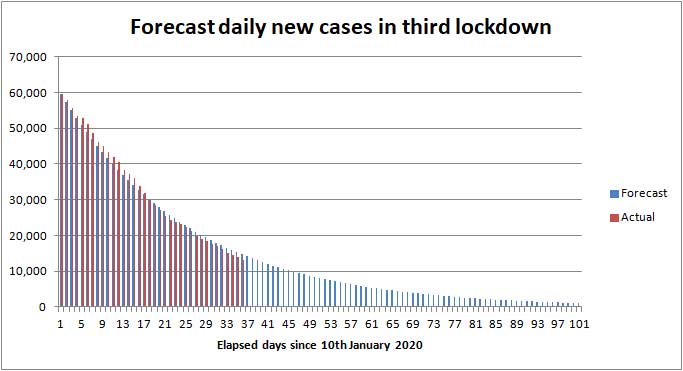
Forecast new daily cases to 20th April 2020
An even steeper fall in cases is possible as more of the population is vaccinated.
Once everyone has been vaccinated (currently September) the restrictions can clearly be relaxed, but easing the restrictions too early could potentially lead to a fourth wave of sickness, a return to pressure on hospitals, and possibly up to 50,000 additional deaths of those aged below 60 years in the very worst case, were COVID to spiral out of control. To avoid that the government is going to have to be very careful about how the restrictions are relaxed during the next 3 months.
In our view the daily number of new cases ideally needs to be kept below 1,000 in order to give Test and Trace the chance to work, which equates to about 10 new cases per 100,000 per week. A factor of ten below this weeks figure.
The death toll will continue to mount until the vaccination programme eventually draws the UK COVID-19 epidemic to a close. We still expect the UK COVID death toll to reach 128,000 by the end of March 2021; see commentary.
Exactly what happens will depend on how carefully the government relaxes the restrictions, the effectiveness of test and trace, any change in the lethality of new variants of the virus, and most importantly the speed of the vaccine rollout.
Advice for Seniors
 The
daily number of new cases of Coronavirus is still unacceptably high,
and we judge the risk MODERATE to
HIGH for Seniors living in the
Malvern Hills district who have not been inoculated; see our annex and riskometer opposite.
The
daily number of new cases of Coronavirus is still unacceptably high,
and we judge the risk MODERATE to
HIGH for Seniors living in the
Malvern Hills district who have not been inoculated; see our annex and riskometer opposite.
The risk could be approaching LOW for most Seniors who have been inoculated more than 3 weeks ago.
If you have not been inoculated and catch COVID there is a significant chance that you will either die or your long term health may be seriously damaged, so take care to protect yourself and those you love. 90% of COVID deaths are in those aged over 60 years according to NHS England statistics.
So if you are offered a jab grasp the opportunity with both hands.
The simple safeguards to remember are still to:
-
wash your HANDS thoroughly, using soap and hot water, for 20 seconds, including after handling deliveries to your home, to kill virus picked up from contaminated surfaces see note 1;
-
wear a FACE mask when unavoidably near other people for example when shopping, visiting hospital or the chemist;
-
SPACE at least 2 metres apart from others see note 2;
-
keep TIME near others as short as possible, see note 3;
-
self-isolate and book a test if you have COVID-19 symptoms (new continuous cough, fever or loss of, or change in, sense of smell or taste).
Hence the mantra:-
HANDS, FACE, SPACE, TIME - GET A TEST if you feel unwell.
Pulse Oximeter
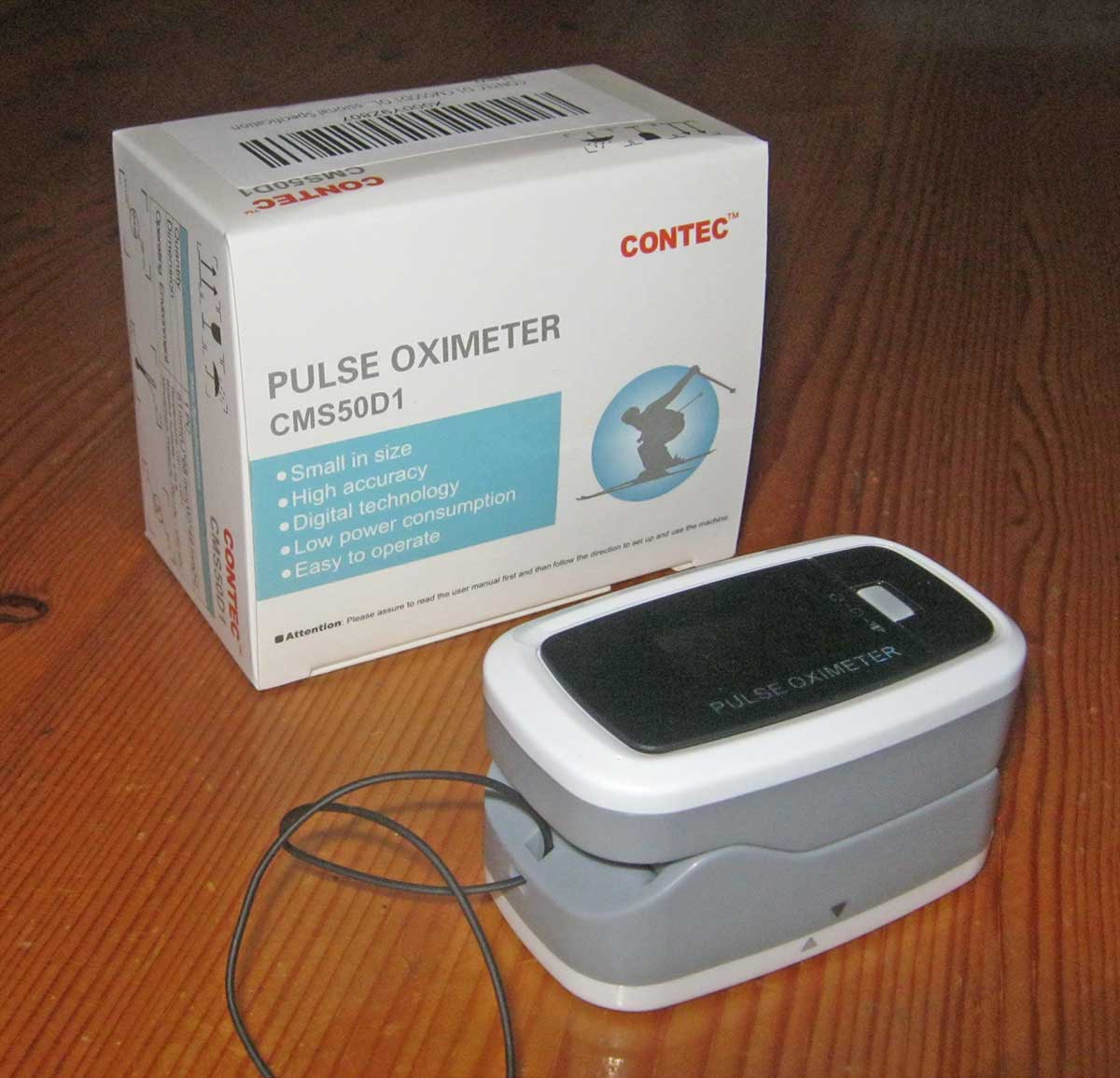 A
doctor in Bournemouth speaking on the evening news suggested
that if you were sick with COVID at home it would be a good idea to have a
little device known as a Pulse Oximeter handy (see photo on right). This
measures the oxygen saturation in the blood and pulse rate by clipping the
device on a finger and pressing a button; the reading should normally be at
least 97%.
A
doctor in Bournemouth speaking on the evening news suggested
that if you were sick with COVID at home it would be a good idea to have a
little device known as a Pulse Oximeter handy (see photo on right). This
measures the oxygen saturation in the blood and pulse rate by clipping the
device on a finger and pressing a button; the reading should normally be at
least 97%.
If the reading falls to about 93% you should call your doctor for advice, and if the reading is consistently below 92% you should consider calling an ambulance or visiting A&E.
Pulse Oximeters can be purchased from Amazon for £18 to £25; alternatively your doctor's surgery might loan you one if you are unwell and have tested COVID positive.
Remember, if you have symptoms of COVID-19 at home and can't count from one to ten out loud due to shortness of breath, you should immediately call your GP, 111 or 999 for advice.
Click for UK government Coronavirus guidance on what you can and cannot do
Notes:
1) Wash your hands thoroughly before touching your face to avoid transferring virus from contaminated surfaces to your mouth, eyes and nose. If outdoors use hand gel.
2) Two metres is further than you think - roughly an arm and a walking stick away.
3) During the National Lockdown you should not mix with other households.
Minimise exposure time if you unavoidably find yourself mixing in a confined setting - an invisible mist of virus can build up in the air if the space is shared with an infectious person; imagine people exhaling cigarette smoke. Unless you wear a well fitting FFP3 hospital grade face mask you can breath this in; a face covering will offer little protection. The likelihood and extent you get sick will depend on the density of the airborne virus, which can be reduced by ventilation, and the duration of your exposure.
Annex to 14th February update
Commentary
Not much seems to have happened this week although there has been increasing speculation about the route out of the third lockdown. People want dates but the scientists are saying ideally the waypoints should be driven by the data and the results of each step evaluated before proceeding to the next.
On Monday Matt Hancock gave a press briefing. He confirmed that vaccination of those aged 70+ years was going well. Take up which was expected to be 75% has been nearer 93%.
Those aged 70+ who do not have appointments for their first jab are now instructed to contact the NHS or their GP surgery to book one.
Test and Trace is performing much better. A contract has been placed with Surescreen Diagnostics of Derby for 20M Rapid Test Kits so businesses of greater than 50 employees will be able to test staff on a daily basis.
Evaluation of new variants of COVID is continuing. The capability to supply booster jabs has been increased by the placing of a contract with Curevac for 50M doses.
Test centres have been set up in areas where the South African variant has been detected. One of these is at the Five Ways Rugby ground on the outskirts of Worcester.
On Tuesday more reports appeared in the media about the setting up of Quarantine Hotels. Travellers arriving in England from 'Red List' countries will have to quarantine for 10 days at a cost of £1,750. Initial provision will be for 4,000 beds and there will be COVID tests at 2 and 8 days. There is to be a fine of £10,000 for avoiding quarantine and a penalty of up to 10 years in jail for anyone deliberately concealing travel from a 'Red List' country.
We had our first COVID jab at Prospect View using the Astrozeneca vaccine.
On Wednesday the Prime Minister held a teatime press briefing the purpose of which was to exhort all those aged 70+ years to book a jab if they had not already had one.
He said the hope was to vaccinate all those in cohorts 1-9, which includes all those aged 50+ years, by the end of April.
Click for PM statement on vaccination programme
Professor John Edmunds speaking later on the Robert Peston show suggested the lockdown should be released cautiously observing the effects of each stage, for example reopening primary schools, before proceeding to the next. In his view people should not be considering overseas holidays at this stage, and the priority should be to vaccinate as fast as possible.
On Thursday the BBC reported that 60% of all COVID deaths were of disabled people, which shocked us.
Click for BBC report on disabled COVID deaths
On Friday the BBC reported the story of a mother who had travelled to Australia to visit a sick relative. She said it was both difficult and expensive to book a flight and travellers were treated like lepers. Her account should put people off visiting Australia this year!
Vaccines
Matt Hancock has said the speed of rollout of the vaccine is currently limited by deliveries from Pfizer in Belgium and Astrazeneca in UK.
The government is expected to meet its target to vaccinate the most vulnerable group (70+) by 15th February.
There has been some uncertainty whether the target is to vaccinate the second group (50-69) by the end April or the end of May.
From mid March the vaccine will have to be diverted to giving second jabs; nevertheless there seems a good chance some of those aged 60+ will have had their first jabs by then.
Vaccination of those aged 50+ by the end of April or May will depend on either the delivery of the Moderna vaccine or deliveries of the Astrazeneca and Pfizer vaccines ramping up.
The timetable for vaccination of those aged 18-49 is more uncertain as four vaccines are yet to be approved. The government's target to do this by September appears realistic, but speculation in the media that this might be accomplished by June appears highly doubtful.
An informative article about the rollout of the COVID vaccine can be found on the BBC website.
Here is a list of the vaccines odered by the uK.
| COVID-19 vaccine | Doses ordered (million) | Status |
| Pfizer BioNTech, two dose, -70 deg C | 40 | Approved, delivery has started, made in Belgium |
| Astrazeneca, two dose, fridge | 100 | Approved, delivery has started after some delay, made in UK |
| Moderna, two dose, -20 deg C | 7+10 | Approved, should be available in the 'spring', supplied from either Switzerland or Spain |
| Valneva, two dose | 60+40 | A jab from French company Valneva will be made in Livingston, West Lothian, Scotland. Delivery to start in second half of 2021. |
| Janssen, single dose | 30 | A jab from Belgian firm Janssen, owned by Johnson and Johnson; phase III trials complete, should be available later this year |
| Novavax | 60 | A jab manufactured by US firm Novavax will be made in Stockton-on-Tees; phase III trials complete, could be available later this year. |
| GSK Sanoft | 60 | Some delay due to adjusting the formula to give better protection to the elderly; possible availability late 2021. |
| Curevac | 50 | Contract placed with German company Feb 2021. Possible source of new variant vaccine later in 2021 |
Table of vaccines ordered by the UK government
Recent deaths in Worcestershire hospitals
The table below shows all COVID deaths in Worcestershire hospitals reported by NHS England to 13th February.
| Worcestershire | Cumulative deaths | Weekly increase | |
| Acute hospitals | 726 | +29 | |
| Care hospitals | 55 | +4 | |
| TOTAL | 781 | +33 |
In the last week 33 additional deaths have been recorded compared to 43 the week before.
Present rate of new cases
This week, the average rate of infection per 100,000 population per week in England fell from 233 to 167. In comparison the figure for Worcestershire is also 167 and that in the Malvern Hills 111.
As a guide we would expect the third lockdown to continue until the rate of infection rate falls to somewhere between 10 and 50 cases per 100,000 per week.
In the meantime Seniors awaiting vaccination need to continue to be careful.
The probability of catching Coronavirus in the Malvern Hills is moderate, but combined with the significant risk of death makes us view the overall risk to Seniors, prior to inoculation, as MODERATE to HIGH.
The risk of death from Coronavirus for healthy teenagers is exceedingly small so for them the risk is LOW, whereas the middle aged can suffer from Long COVID so for them the risk might be assessed MODERATE.
Forecast of death rate during February and March
The average UK COVID daily death rate peaked at 1,200 deaths per day about 25th January and has begun to fall principally due to physical distancing. In coming weeks the vaccination programme should lead to an even faster fall in the death rate with deaths possibly tailing off to 100 deaths per day or less during March.
We predict the rolling 7 day average death rate will fall from 672 to 420 by 21st February, dropping to 260 deaths per day (or less) by the end of the month, resulting in about 6,200 additional deaths.
Then assuming the death rate falls further to 100 deaths per day by the end of March as a result of the vaccination of over 60 year olds, the average could be 180 deaths per day in March leading to about 5,400 further deaths.
Adding these 'back of the envelope' numbers suggests the UK COVID-19 death toll could reach 128,766 by the end of March.
| Date | Forecast UK COVID-19 death toll (PHE) |
| February 14th | 117,166 |
| February 28th | +6,200 |
| March 31st | +5,400 |
| Total | 128,766 |
Forecast UK COVID-19 epidemic death toll by end March 2021
Another projection of the future COVID-19 death toll and daily deaths can be found on The Institute for Health Metrics and Evaluation website:
Click for IHME projection of COVID-19 deaths
The latest projection is for 156,000 deaths by the end of March which probably won't be far off the figure reported by the ONS.
At the start of the epidemic in March the Chief Scientific Adviser, Sir Patrick Valance, suggested a death toll of 20,000 would be a good outcome; on the other hand, Professor Neil Ferguson of Imperial College warned in some scenarios the death toll might be as high as 250,000; while we thought, in the very worst case assuming up to 1% of the UK population died the outcome might have been nearer 400,000 taking into account some build up of herd immunity.
So how well will the UK have done? When Sir Patrick Valance spoke off the top of his head there had been few deaths and he clearly did not want to 'scare the horses'. Professor Neil Ferguson was nearest the mark. A few might consider an outcome of 128,000 deaths a fair result compared to a greater number of people dying in a very short space of time, more being permanently disabled by Long COVID, and temporary collapse of the NHS. Members of the Labour Party and others will no doubt say the UK has done very poorly compared to the best performing countries such as Australia, New Zealand and Singapore where deaths have been much lower, not to mention the enormous expense of supporting those out of work and huge damage to the economy.
Ultimately there can be no winners or losers, but there must eventually be a thorough inquiry to learn lessons for the future.
Summary of Links
Symptoms
Article about the effects of Coronavirus on the human body
Reporting and how to obtain a test
How to get a test
https://www.nhs.uk/coronavirus
About joining the Zoe COVID Symptom Study:
Guidance
UK government Coronavirus guidance
Tiers
Guidance on tiers: what you need to know
Government postcode checker to find tier for other areas
Statistics
UK government Coronavirus Dashboard
Coronavirus Dashboard Interactive Map
ONS data on deaths in England and Wales (Excel spreadsheet)
NHS England COVID-19 Daily Deaths
NHS England COVID-19 Hospital Admissions
NHS England vaccination statistics
Reports
ONS Coronavirus (COVID-19) Roundup
The bigger picture
Worldometer summary of coronavirus cases worldwide
European Centre for Disease Prevention and Control info
https://www.ecdc.europa.eu/en/geographical-distribution-2019-ncov-cases
World Health Organisation info
Window on the USA
Centre for Disease Control (CDC)
American Association of Retired People (AARP)
Worcestershire
Help:
http://www.worcestershire.gov.uk/here2help
Worcestershire County Council COVID-19 information:
http://www.worcestershire.gov.uk/coronavirus
Here you will find a useful link,
'Website: Number of new cases by date in Worcestershire'
which displays interesting COVID charts and statistics for Worcestershire
Miscellaneous
Spanish Flu
Dr Jeff Kildea's commentary about the 1919 outbreak of Spanish Flu in Australia
Views of Martin McKee, Professor of European Public Health
Follow Martin McKee on Twitter
SAGE membership
Scientific Advisory Group for Emergencies (SAGE)
Scottish government:
Link to Scottish Government website
Link to Postcode checker for COVID restrictions by protection level in areas of Scotland
Welsh Government:
Guidance on COVID alert levels in Wales

The interpretations and opinions expressed are our own
Last updated 14th February 2021
 Blogs
>
Blogs
>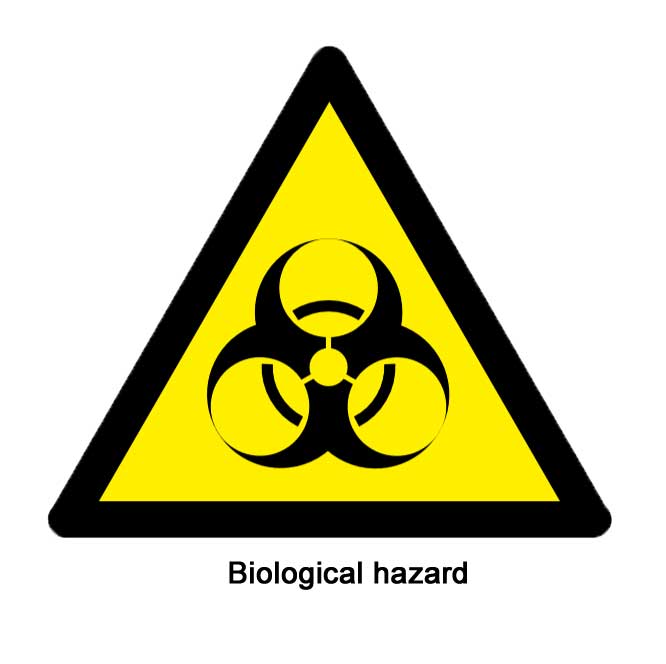 How
to request a test
How
to request a test Please
consider helping others by downloading the COVID Symptom Study app onto your
smart phone or Ipad and reporting how you feel either daily, or as you are
able. Note that currently there is no desktop PC version.
Please
consider helping others by downloading the COVID Symptom Study app onto your
smart phone or Ipad and reporting how you feel either daily, or as you are
able. Note that currently there is no desktop PC version.